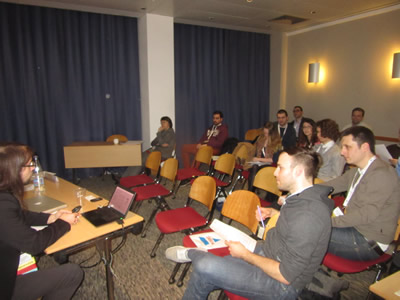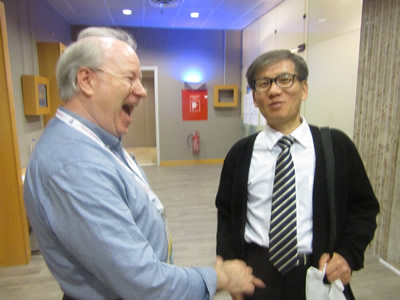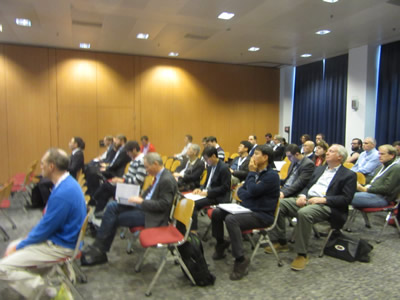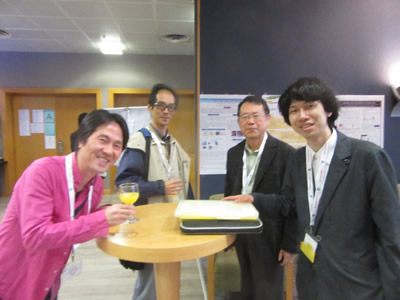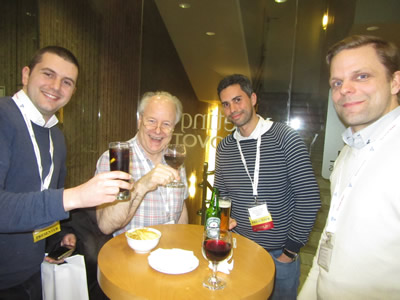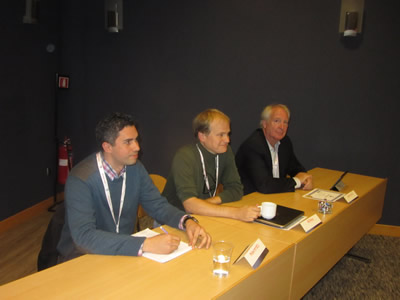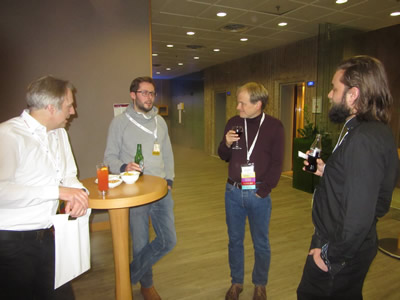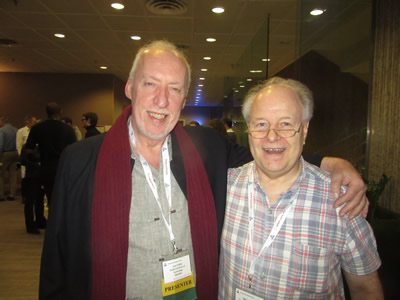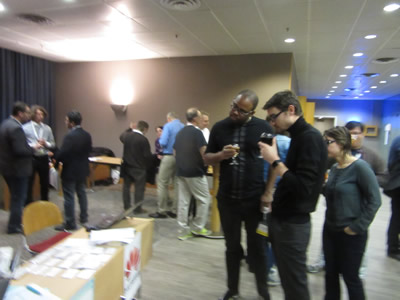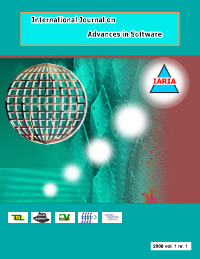GEOProcessing 2019 - The Eleventh International Conference on Advanced Geographic Information Systems, Applications, and Services
February 24, 2019 - February 28, 2019
GEOProcessing 2019: Call for Papers
Geographical sensors and satellites provide a huge volume of spatial data which is available on the Web. Making use of Web Services, the users are able for provisioning and using these services instead of only for document searching. These services are published in a directory and may be automatically discovered in a given context by software agents. Accessing large digital geographical libraries with geo-spatial information raises some challenges with respect to data semantics, interfaces, data accuracy and updates, distributed processing, as well as with discovery, indexing and integration of geographical information systems; this raise the issue of distributed catalogs forming a federation of spatial databases. Some spatial data infrastructures use service-oriented architecture for accessing these large databases via Web Services.
The goal of the International Conference on Advanced Geographic Information Systems, Applications, and Services, GEOProcessing 2019, is to bring together researchers from the academia and practitioners from the industry in order to address fundamentals of advances in geographic information systems and the new applications related to them using the Web Services. Such systems can be used for assessment, modeling and prognosis of emergencies. As an example, it can be used for assessment of accidents from chemical pollution by considering hazardous chemical zones dimensions represented on a computer map of the region's territory.
The conference will provide a forum where researchers shall be able to present recent research results and new research problems and directions related to them. The conference seeks contributions presenting novel research in all aspects of techniques and technologies applied to geographic information systems and Web Services.
We solicit both academic, research, and industrial contributions. We welcome technical papers presenting research and practical results, position papers addressing the pros and cons of specific proposals, such as those being discussed in the standard fora or in industry consortia, survey papers addressing the key problems and solutions on any of the above topics short papers on work in progress, and panel proposals.
Industrial presentations are not subject to the format and content constraints of regular submissions. We expect short and long presentations that express industrial position and status.
Tutorials on specific related topics and panels on challenging areas are encouraged.
The topics suggested by the conference can be discussed in term of concepts, state of the art, research, standards, implementations, running experiments, applications, and industrial case studies. Authors are invited to submit complete unpublished papers, which are not under review in any other conference or journal in the following, but not limited to, topic areas.
All topics and submission formats are open to both research and industry contributions.
GEOProcessing 2019 conference tracks:
Geo-spatial fundamentals
Fundamentals of geo-information; New trends in GIS technologies and research; Techniques for geographical representation; Integrated architectures for geo-spatial information; Geo-spatial data in net-centric environment; Geo-spatial technology; Discovery, indexing and integration of geographical information systems; Geo-processing of distributed data; Geo-information processing; Use of computational geometry for GIS problems; Virtual globes and their application to scientific research; Spatial decision support systems
Trends in Geo-cognition
Cognitive geo-spatal images; Real 3D and Pseudo -3D cartographic visualization; Geographic cognitive models for cyberspace; Spatial pattern cognition; Tactile maps and graphics; Spatio-textual similarity; Toponym disambiguation; Geo-spatial intelligence and open source data; Distributed convoy pattern mining; Activity recognition of passengers (bus, airlines, railway, taxi, etc.); Fusing data from smart phones; Collaborative navigation; Visual perception in landscapes; Pedestrian mobility behavior patterns; Business news spatio-temporal data; Geo-social co-location mining; Spatial drift analysis; Processing cascading information; Web 2.0 Geo-search
Trends on Big Geo-Data
Public Geospatial information; Visualizations of movement data; Storage and Indexing spatial big data; Geospatial Big Data analytics; MapReduce for spatial data; Geographical hotspots; Large-scale geospatial data; Global-scale Earth data in Cloud; Detecting geo-anomalies; Geosocial data; Historical maps and big data; Big data and satellite imagery; Graph-based tractography; Web-based mapping; Geotagged Twitter data; Twitter hashtag discovery; Geo-sensor networks; Geospatial data semantic catalogue; Processing large spatial queries
Trends of Urban-Geo
Interactive maps; Cartographic rules and geographic features; Audio enhanced map animation; Map legibility and automated cartography; Spatial decisions and urban planners; Maps and demographic uncertainty for demographic; Emotional maps and Smart Cities decisions; End-User centered flood evacuation maps; Noise maps; Avalanche hazard maps; Location data and privacy; Scientific terrain visualization; Vehicular spatio-temporal computing; Urban spatial crowdsourcing; Personal driving preferences map; Street networks semantics; Self-similarity in urban traffic systems; Optimizing public and private transportation maps; Traffic and road sensor data; Interactive facility maps (gas stations, electric vehicular points, banks, etc.); Time-depended routing maps (emergency, ambulance, fire-stations, etc.); CO2 emissions maps; Visible landmarks; Connected cell towers maps; Public transport assistance
Geo-spatial Web Services
Geo-spatial Web Services and applications; Geo-spatial Web Services and simulation and modeling; Geo-spatial Web Services and sensors; Geo-spatial Web Services and interoperability; Geo-spatial Web Services and processing; Geo-spatial Web Servcies and spatial analysis; Geo-spatial Web Services and society; Geo-spatial Web Services and information retrieval; Geo-spatial Web Services and human computer interaction; Geo-spatial Web Services and mobility
Assessment of Spatial Data Quality
Assessing Quality of Volunteered Geographic Information; Frameworks and automated methods to assess spatial data quality; Assessing spatial data fitness for use; Development of new indicators of spatial data quality; Spatial data quality communication and visualization.
GIS
Wireless and mobile GIS; Integration of remote sensing, GIS and GPS; Statistics and application models of spatial data; GIS for the environment and health; Satellite positioning technology and LBS; Urban GIS and its applications; Theories and algorithms in GIS; Government and public GIS
Geo-spatial simulation and visualization
2D and 3D information visualization; Distributed simulations and sensor webs; Simulation modeling dynamic geo processes; Exploratory spatial data analysis; Fine-grained, terrestrial monitoring platforms; Geo-visualization and geo-visual analytics; Visualization of geospatial uncertainty; Representation and visualization of geospatial data
Geo-modeling
Standards and geo-spatial metadata; Novel geo-spatial data processing and management mechanisms; Spatio-temporal data modeling and reasoning; 3D modeling and GIS; Modeling and analysis of terrains; Modeling uncertainty in geo-spatial information; Spatial and spatio-temporal statistics; Geo-spatial and spatio-temporal data mining; Virtual modeling of large geographic areas; Time-geography modeling; Geospatial data analytics
Digital cartography data
Digital geographical libraries; Exploratory cartography and interfaces; Digital cartography; Automated mapping and map generalization; Cartographic theory and applications; Data models in cartography; Geographical search engines
Earth Geo-observation
Climate change and the global environment; Data systems for the future Earth observation satellites; Calibration and validation of remotely sensed data; Earth observation sensor networks and applications; Earth observation technology and systems
Geo-sensing
Acquisition and processing of remotely sensed data; Information extraction from remotely sensed data; Data mining across sensor; Intelligent sensors/sensor fusion; Co-operative sensing and organization; Sensor information management systems; Spatio-temporal sensor data mining; Sensor networks and interaction with actuators; Geo-sensor specialized networks (e.g. disaster management, early warning systems, environmental monitoring)
Specific geo-data processing
Seismic data processing (stacking, migration, post-processing, interpretation); Tomography (algorithms, methods); Electromagnetic sounding; Near surface methods (archaeology, urban and environmental planning); Combined geophysical methods (gravimetry, magnetics, borehole methods); Seismology and planetology; Geo-natural data on phenomena (hurricane, winds, flooding, etc.); Underground geo-reserves, natural resources, exploration (gas, oil, metals, etc.); Natural geo-evolution and morphology (glaciers, oceanic streams, etc.); Geo-marine life; Geology and earth system simulation and modelling
Geo-spatial domain applications
Geospatial Technologies for Disaster Management;Geology and hydrogeology geographical data; Standardization of geodata and geoservices; Environment and land surveying; Oceanographic geo-information; Natural resource information systems; Remote sensing geospatial data collection; Geo-spatial data and vehicular technologies; Geology and Hydrology applications; Location-based services; Environmental monitoring; Special applications: 3D cadastre, traffic management, etc.
Managing geo-spatial data
Managing uncertainty in spatial information; Automatic mapping (possibly web-based ...); Digital elevation/shape modeling; Web-based visualization of statistical data within a geographic framework; Tools and links between GIS and statistical software packages; Business mapping (spatial analysis for business processes as customer segmentation, churn analysis, etc.); Wireless sensor networks for spatial applications; Errors and their measurement in spatial data
Deadlines:
Submission | Nov 13, 2018 |
Notification | Dec 13, 2018 |
Registration | Dec 27, 2018 |
Camera ready | Jan 10, 2019 |
Deadlines differ for special tracks. Please consult the conference home page for special tracks Call for Papers (if any).
INSTRUCTION FOR THE AUTHORS
Authors of selected papers will be invited to submit extended versions to one of the IARIA Journals.
Publisher: XPS (Xpert Publishing Services)
Archived: ThinkMindTM Digital Library (free access)
Prints available at Curran Associates, Inc.
How to submit to appropriate indexes.
Only .pdf or .doc files will be accepted for paper submission. All received submissions will be acknowledged via an automated system.
Contribution types
- regular papers [in the proceedings, digital library]
- short papers (work in progress) [in the proceedings, digital library]
- ideas: two pages [in the proceedings, digital library]
- extended abstracts: two pages [in the proceedings, digital library]
- posters: two pages [in the proceedings, digital library]
- posters: slide only [slide-deck posted on www.iaria.org]
- presentations: slide only [slide-deck posted on www.iaria.org]
- demos: two pages [posted on www.iaria.org]
FORMATS
Only .pdf or .doc files will be accepted for paper submission. All received submissions will be acknowledged via an automated system.
Final author manuscripts will be 8.5" x 11", not exceeding 6 pages; max 4 extra pages allowed at additional cost.
Helpful information for paper formatting for MS Word can be found here.
There is a community provided LaTeX template: the CTAN package iaria (with full IARIA formatting rules, including IARIA citation style, but for providing citation style it is tightly bound to pdflatex+biblatex+biber). In addition, there is also iaria-lite (not bound to pdflatex+biblatex+biber, but compatible with any TeX stack; thus, it cannot provide the IARIA citation formattings, but only the titlepage and content-related IARIA formatting rules). Based on the iaria package, there is a minimal working example as Overleaf template. When you are using the LaTeX templates, please still adhere to the additional editorial rules.
Slides-based contributions can use the corporate/university format and style.
Your paper should also comply with the additional editorial rules.
Once you receive the notification of contribution acceptance, you will be provided by the publisher an online author kit with all the steps an author needs to follow to submit the final version. The author kits URL will be included in the letter of acceptance.
We would recommend that you should not use too many extra pages, even if you can afford the extra fees. No more than 2 contributions per event are recommended, as each contribution must be separately registered and paid for. At least one author of each accepted paper must register to ensure that the paper will be included in the conference proceedings and in the digital library, or posted on the www.iaria.org (for slide-based contributions).
CONTRIBUTION TYPE
Regular Papers (up to 6-10 page article -6 pages covered the by regular registration; max 4 extra pages allowed at additional cost- ) (oral presentation)
These contributions could be academic or industrial research, survey, white, implementation-oriented, architecture-oriented, white papers, etc. They will be included in the proceedings, posted in the free-access ThinkMind digital library and sent for indexing. Please submit the contributions following the instructions for the regular submissions using the "Submit a Paper" button and selecting the appropriate contribution type. 12-14 presentation slides are suggested.
Short papers (work in progress) (up to 4 pages long) (oral presentation)
Work-in-progress contributions are welcome. These contributions represent partial achievements of longer-term projects. They could be academic or industrial research, survey, white, implementation-oriented, architecture-oriented, white papers, etc. Please submit the contributions following the instructions for the regular submissions using the "Submit a Paper" button and selecting the contribution type as work in progress. Contributors must follow the conference deadlines, describing early research and novel skeleton ideas in the areas of the conference topics. The work will be published in the conference proceedings, posted in the free-access ThinkMind digital library and sent for indexing. For more details, see the Work in Progress explanation page. 12-14 presentation slides are suggested.
Ideas contributions (2 pages long) (oral presentation)
This category is dedicated to new ideas in their very early stage. Idea contributions are expression of yet to be developed approaches, with pros/cons, not yet consolidated. Ideas contributions are intended for a debate and audience feedback. Please submit the contributions following the instructions for the regular submissions using the "Submit a Paper" button and selecting the contribution type as Idea. Contributors must follow the conference deadlines, describing early research and novel skeleton ideas in the areas of the conference topics. The work will be published in the conference proceedings, posted in the free-access ThinkMind digital library and sent for indexing. For more details, see the Ideas explanation page. 12-14 presentation slides are suggested.
Extended abstracts (2 pages long) (oral presentation)
Extended abstracts summarize a long potential publication with noticeable results. It is intended for sharing yet to be written, or further on intended for a journal publication. Please submit the contributions following the instructions for the regular submissions using the "Submit a Paper" button and selecting the contribution type as Extended abstract. Contributors must follow the conference deadlines, describing early research and novel skeleton ideas in the areas of the conference topics. The work will be published in the conference proceedings, posted in the free-access ThinkMind digital library and sent for indexing. 12-14 presentation slides are suggested.
Posters (paper-based, two pages long) (oral presentation)
Posters are intended for ongoing research projects, concrete realizations, or industrial applications/projects presentations. The poster may be presented during sessions reserved for posters, or mixed with presentation of articles of similar topic. A two-page paper summarizes a presentation intended to be a POSTER. This allows an author to summarize a series of results and expose them via a big number of figures, graphics and tables. Please submit the contributions following the instructions for the regular submissions using the "Submit a Paper" button and selecting the contribution type as Poster Two Pages. Contributors must follow the conference deadlines, describing early research and novel skeleton ideas in the areas of the conference topics. The work will be published in the conference proceedings, posted in the free-access ThinkMind digital library and sent for indexing. 8-10 presentation slides are suggested. Also a big Poster is suitable, used for live discussions with the attendees, in addition to the oral presentation.
Posters (slide-based, only) (oral presentation)
Posters are intended for ongoing research projects, concrete realizations, or industrial applications/projects presentations. The poster may be presented during sessions reserved for posters, or mixed with presentation of articles of similar topic. The slides must have comprehensive comments. This type of contribution only requires a 8-10 slide-deck. Please submit the contributions following the instructions for the regular submissions using the "Submit a Paper" button and selecting the contribution type as Poster (slide-only). The slide-deck will be posted, post-event, on www.iaria.org.
8-10 presentation slides are suggested. Also a big Poster is suitable, used for live discussions with the attendees, additionally to the oral presentation.
Presentations (slide-based, only) (oral presentation)
These contributions represent technical marketing/industrial/business/positioning presentations. This type of contribution only requires a 12-14 slide-deck. Please submit the contributions following the submission instructions by using the "Submit a Paper" button and selecting the contribution type as Presentation (slide-only). The slide-deck will be posted, post-event, on www.iaria.org.
12-14 presentation slides are suggested.
Demos (two pages) [posted on www.iaria.org]
Demos represent special contributions where a tool, an implementation of an application, or a freshly implemented system is presented in its alfa/beta version. It might also be intended for thsoe new application to gather the attendee opinion. A two-page summary for a demo is intended to be. It would be scheduled in special time spots, to ensure a maximum attendance from the participants. Please submit the contributions following the submission instructions by using the "Submit a Paper" button and selecting the contribution type as Demos. The Demos paper will be posted, post-event, on www.iaria.org.
Tutorial proposals
Tutorials provide overviews of current high interest topics. Proposals should be for 2-3 hour long. Proposals must contain the title, the summary of the content, and the biography of the presenter(s). The tutorial slide decks will be posted on the IARIA site.
Please send your proposals to tutorial proposal
Panel proposals
The organizers encourage scientists and industry leaders to organize dedicated panels dealing with controversial and challenging topics and paradigms. Panel moderators are asked to identify their guests and manage that their appropriate talk supports timely reach our deadlines. Moderators must specifically submit an official proposal, indicating their background, panelist names, their affiliation, the topic of the panel, as well as short biographies. The panel slide deck will be posted on the IARIA site.
Please send your proposals to panel proposal
